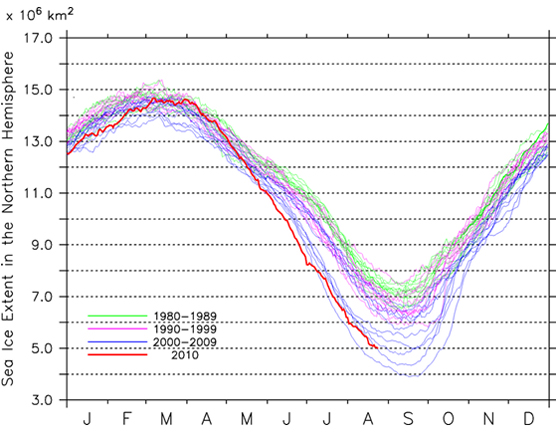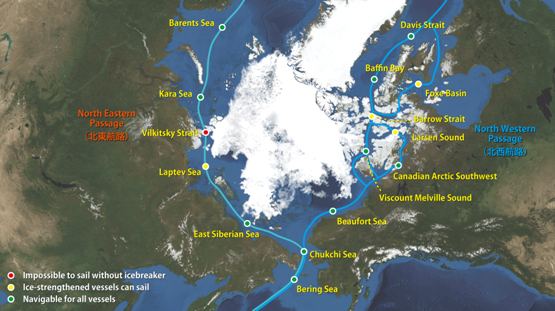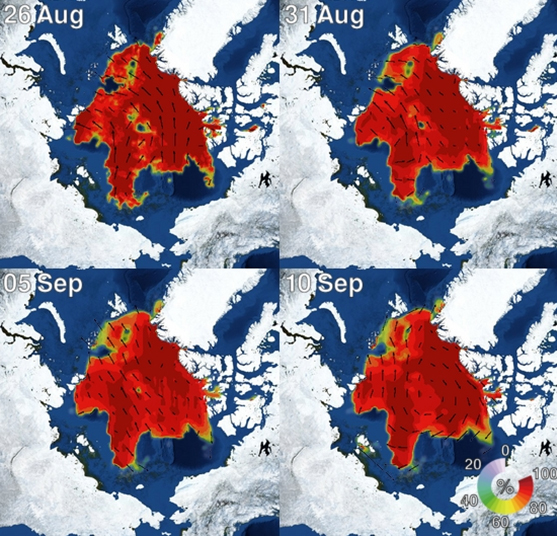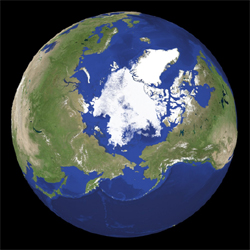2010.08.26
GIC Weekly Report Vol.4
Although NW Passage is not yet open, melting continues towards the minimum.
Topic of the Week
The sea ice extent in the Arctic Ocean has continued to decrease throughout this week. Considering the rapid sea ice retreat observed over the past few weeks, an opening of the Northwestern Passage has been expected as mentioned in the previous report. The passage, however, still remains closed because of sea ice remaining over several key areas along the main route in the passage, such as Viscount Melville Sound and Barrow Strait.
Compared to the western Arctic, sea ice melting in the eastern Arctic has been relatively moderate throughout this summer. Now sea ice has gradually cleared off from the Laptev Sea, but substantial amount of ice still resides at the mouth of the Vilkitsky Strait, hampering sailing routes in the Northeastern passage.
The Arctic sea ice extent is forecast to continue declining for several more weeks towards the upcoming minimum extent in early September. Therefore, it is still worth keeping an eye on sea ice conditions in the western as well as eastern Arctic regions for a while.
Sea Ice Extent

|
Arctic Western Arctic Eastern Arctic |
Figure 1a-1c. Sea ice extent of the entire Arctic(1a), western Arctic(1b), and eastern Arctic(1c)
Figure 1a shows the change in sea ice extent in the entire Arctic. The current sea ice extent is estimated to be approx. 5.0 million square kilometers. This value is still at a similar level to the second lowest extent for this time of year seen in summer 2008. The loss of ice extent over the past week is estimated to be about 0.5 million square kilometers.
The decline curve suggests that the Arctic sea ice has continued to decrease, the trend, however, has to some extent subsided during this week due in part to a slightly slowed down melting over the western Arctic as seen in Figure 1b. The sea ice extent over the eastern Arctic, on the other hand, has shown
a moderate decline, following the trend seen over the past few weeks.
Figure 2 illustrates a snapshot of the current sea ice conditions in the Arctic Ocean derived from passive microwave satellite imagery. In this picture, sea ice in the western Arctic, particularly those in coastal areas of the Canadian Arctic Archipelago, appears to be largely melted out.
Although sea ice extent in the eastern Arctic as a whole is keeping its moderate decline, several extended areas of thick sea ice are still observable in the East Siberian Sea and the Laptev Sea.
Sea Ice Conditions along Polar Routes

Figure 3. Sea ice condition around the North Eastern and North Western passages.
Figure 3 depicts the current conditions of the polar routes on top of the microwave satellite imagery. Continuing from the previous period, neither of the polar routers are completely open yet.
In the Canadian islands, although substantial amount of sea ice has been melting away over the past few weeks, the Northwestern Passage is not yet navigable because of some residual sea ice distributions along the coastal areas. Several icy areas in Viscount Melville Strait and Barrow Strait keep to obstruct the main route, and a scattered sea ice populated over an area between Victoria Island and King William Island still blocks the southern route.
In the eastern Arctic, the Northeastern Passage has been still hindered by sea ice extended across coastal areas of the Vilkitsky Strait. Therefore sea ice retreat in the Laptev Sea, particularly, over the coast area of the strait, will be a key for the opening of the passage during this melting season.
Model Prediction
Figure 4 shows the forecast of the Arctic sea ice distribution in 26 August to 10 September based on Weathernews' I-SEE engine. The forecast suggests that sea ice extent in the Arctic will continue to decrease for several more weeks, and the sea ice is slated to reach its minimum extent sometime in early September. If the trend of ice decline continues and melting proceeds with the present speed over the coastlines of the Canadian islands, the main route in the Northwestern Passage may possibly become navigable within this summer, after the opening in summer 2008.

Figure 4. I-SEE engine model predictions of Arctic sea ice.


